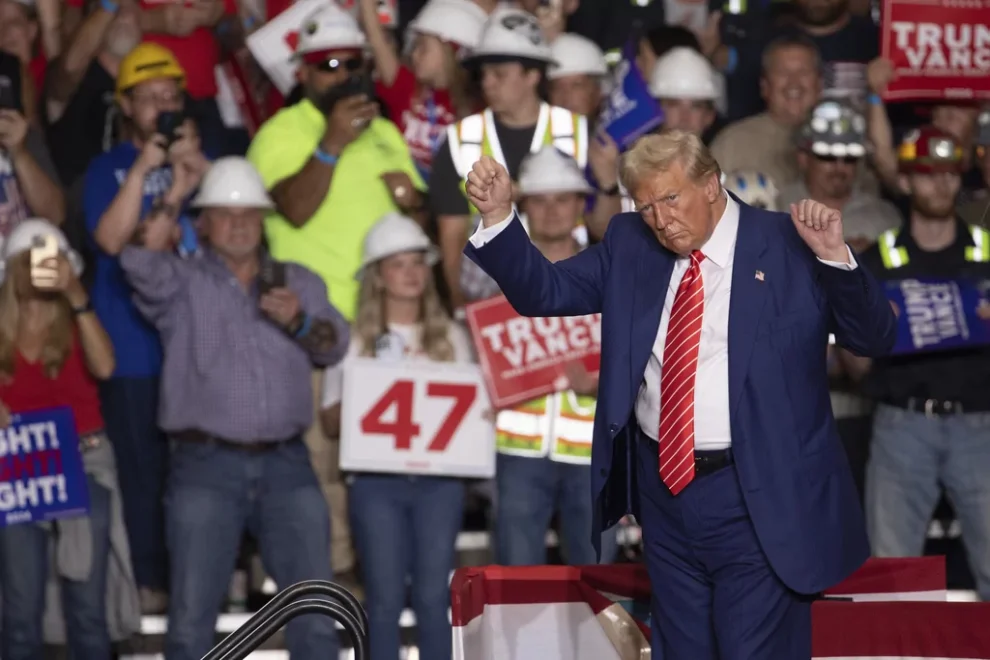Vice President Kamala Harris and former President Donald Trump are battling over just seven battleground states in the lead-up to the November showdown to replace President Joe Biden.
But their similar, yet still divergent, travel and spending strategies reveal where their campaigns see as the best strategy to win the 270 Electoral College votes needed to secure the White House.
Both campaigns are spending plenty of time in Pennsylvania, the battleground state that will likely determine the winner of the election with its 19 electoral votes.
Harris spent part of her Labor Day travel in Pittsburgh and will return back to the city Thursday making it her 10th visit to Pennsylvania this year. Harris’s running mate, Gov. Tim Walz (D-MN), is on a barnstorm of the Keystone State, his first solo tour since joining the Democratic ticket, ahead of next week’s presidential debate held in Philadelphia.
Trump spent part of Wednesday afternoon in Harrisburg filming a Fox News town hall with Sean Hannity. His running mate, Sen. J.D. Vance (R-OH), spent parts of last week in Pennsylvania and Michigan and campaigned in Arizona on Wednesday night.
“Pennsylvania has a political bullseye on it,” said Christopher Nicholas, a veteran Republican political consultant and publisher of the PA Political Digest newsletter. “The Philadelphia TV market, one of our six indigenous TV markets, it’s been the scene of the most political ads ever. Most political ads total in this election year.”
Roughly the same amount of money has been reserved in Pennsylvania between Labor Day and Election Day for both candidates, with $70.8 million in support of Democrats and $70.6 million in support of the GOP, according to AdImpact.

But in total, Harris has vastly outraised Trump, with her campaign boasting $370 million in digital and television ad reservations running from Labor Day to Election Day. Her campaign has already launched four ads attacking Trump on the economy since last month’s Democratic National Convention.
Despite this advantage, Harris’s campaign is attempting to brand itself as the underdog in the campaign in a recent September memo. “Make no mistake: we head into the final stretch of this race as the clear underdogs,” wrote campaign Chairwoman Jen O’Malley Dillon. “Donald Trump has a motivated base of support, with more support and higher favorability than he has had at any point since 2020.”
The best paths to 270
Harris’s best pathway to the White House involves winning Pennsylvania, Wisconsin, and Michigan, collectively known as the blue wall states.
If she were to win those three states in addition to one electoral vote in Nebraska, she could lose the four other battleground states and still win 270 electoral votes compared to Trump’s 268 votes, according to a hypothetical scenario on the 270 to win website.
Trump’s best-case scenario for the White House would be to win Pennsylvania, dealing Harris a heavy blow, Georgia, and North Carolina putting him at 270 votes to Harris’s 268 votes.
Harris and Walz’s travel schedule has shown just how important the blue wall is for Democrats. In her first campaign rally after replacing Biden, the vice president appeared before a friendly Wisconsin crowd in late July.
The first rally featuring the joint Harris-Walz ticket was held in early August in Philadelphia in which they launched a battleground state tour. She and Walz returned back to the state in mid-August, one day before the Democratic convention in Chicago began.
Harris spent part of Labor Day in Detroit, Michigan, her second visit since she became the nominee. She and Walz were previously in Detroit at the beginning of August. As the Democratic convention was convening last month, Harris and Walz held another rally at the Fiserv Forum in Wisconsin on the same night as the ceremonial roll call vote.
Trump has opted for a lighter travel schedule than Harris, choosing instead to hold press conferences at Mar-a-Lago and Bedminster, New Jersey, slamming the vice president while Vance hits the campaign trail.
But in early August, he and Vance traveled to Atlanta to campaign together, and roughly two weeks ago, Trump held a rally in Charlotte, North Carolina. Last week, Trump appeared in Johnstown, Pennsylvania, for another rally where he announced his support for the government to pay for in vitro fertilization in a second administration.
GOP strategists echoed O’Malley Dillon’s comments in an interview with the Washington Examiner when asked to compare the two campaigns.
“Remember, Trump’s always had less money,” said Republican strategist Ford O’Connell. “I mean Clinton, Biden, he’s always done it. But he also gets very strategic about it — like you see him doing a lot of these podcasts so that he can [get] Gen Z males in particular.”
The former president recently appeared on the Lex Fridman podcast, which was released Tuesday afternoon, a move that is likely meant to appeal to young male voters and counteract the left-leaning tilt of young female voters.
A ‘turnout election’
Although Trump was outraised by Hillary Clinton in 2016, he still defeated the Democrat but fell short in his 2020 battle against Biden.
“When you look at the fact that there are so few swing states, I think it negates a lot of Harris’s financial advantage because the playing field is relatively narrow,” added Nicholas. Trump won Pennsylvania by just more than 44,000 votes in 2016 against Clinton, while Biden won the state by a little over 80,000 votes in 2020.
Polling suggests the race for the Keystone State will be close. Harris and Trump are tied at 47% in Pennsylvania, according to a new CNN poll released Wednesday, and the pair are also tied in the Keystone state at 47.2%, according to a RealClearPolitics poll average.

But ultimately the race for the White House will likely be decided by who can win the blue wall states — Pennsylvania, Wisconsin, and Michigan — and who can win the Sunbelt states — Arizona, Georgia, North Carolina, and Nevada.
“What you’re seeing from Trump is he wants to steal one of the three blue wall states, and obviously Pennsylvania gives him the best chance to do it. But he wants to push the envelope in Michigan and Wisconsin as well,” said O’Connell. “That’s why I think, on Saturday he’s going to Wisconsin. Now, what is Harris trying to do? She’s trying to hold serve in those three blue wall states while trying to short-circuit Trump in the Sunbelt in case he does win Pennsylvania.”
However, Republican National Committee Chairman Michael Whatley defended the Trump campaign’s strategy during a recent media appearance.
“We’re playing offense and they are playing defense,” Whatley said on Fox News’s America’s Newsroom. “That’s the simplest way to put it. … Donald Trump is reaching out to every single American family, he’s reaching out to every single voter, and that includes states like Virginia and New Hampshire and Minnesota, where the Democrats are having to play defense.
“You think about every single one of the battleground states that we’re playing in right now, Donald Trump has leads. Donald Trump is solidifying those leads,” he continued. “Kamala Harris’s sugar high has ended, and we are returning right now, coming out of Labor Day, into this campaign season for real, and Donald Trump is in a great place and we’re playing offense.”
Harris raised eyebrows this week during a campaign tour stop in New Hampshire, a purple state but not considered a battleground state, where she announced a new economic plan to boost small business owners.
But political strategists claimed that the visit gave her another opportunity to thwart the Trump campaign.
“Harris is traveling down a couple different paths to capture at least 270 electors and thereby the presidency,” said Dennis Lennox, a Republican strategist. “Some of her travels may also be a deke — like going to New Hampshire or perhaps North Carolina. It’s not that she thinks New Hampshire is a real battleground or that she can win New Carolina as much as it is a deke to divert Trump spending and visits away from a Pennsylvania or a Georgia.”
CLICK HERE TO READ MORE FROM THE WASHINGTON EXAMINER
Lennox also argued the race will come down to a turnout issue, not a spending competition between Trump and Harris.
“I’m less concerned about ad buys right now because there are so few undecided voters,” he said. “I’m more concerned about turnout — this is a turnout election. And that’s especially important as absentee and early mail-in ballots start dropping any day now.”
Asher Notheis contributed to this report.
























